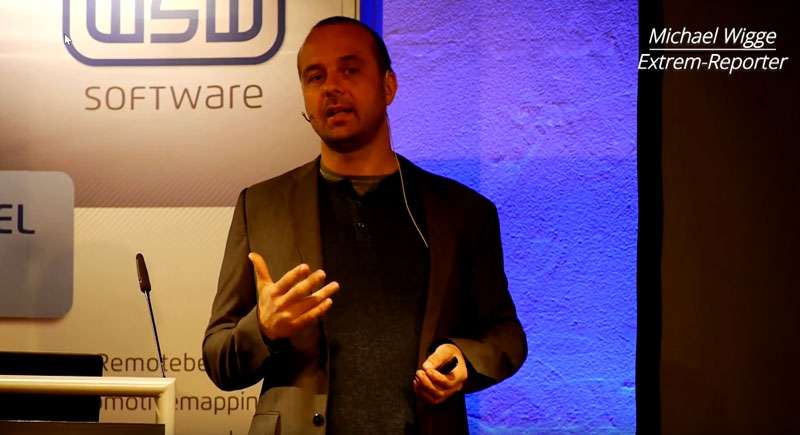Top Motivational Speaker – Leadership
Michael Wigge’s L.E.A.D.E.R. Success Keynote- 2024/2025

Top Motivational Leadership Speaker Michael Wigge’s Challenge-4-Change – Leadership Success keynotes and workshops inspire the leadership greatness inherent in every individual.
Table of Content:
The Top Motivational Leadership Speaker Offers:
- Among the top 100 motivational leadership speakers in the U.S.
- Unique appearances, such as on The Tonight Show
- L.E.A.D.E.R. Success keynote on leadership for C.E.O.s, managers, management staff, and executives
- Incredible audience entertainment and interactions
- Outstanding life story and adventure challenges like How to Travel the World for Free
- Complimentary booking signing for all meeting participants
- Get your free quote before booking any speakers
Top Motivational Leadership Keynote – 6 Aspects of L.E.A.D.E.R.
L for Listening
Master the art of active listening, identifying where, when, and how much. Learn what the world’s most outstanding leaders do to impact history. Garner the courage to make mistakes to grow and increase your influence. Learn from a leadership keynote speaker how one’s failure can be the key to growth and success by actively listening to your network’s feedback.
E for Embracing Change
Learn how to challenge yourself to turn fear of change into a desire for change. Great leaders embrace change for personal and professional growth, to satisfy their customers, and to keep the company environment exciting and motivating for their employees.
A for Assisting
As a leader, it’s your job to help others understand the bigger picture, help them define their contributions to larger business objectives, and give them what they need to meet those communicated performance goals. Assist with generosity and lead with courage.
D for Decisiveness
Great leaders are decisive. They can decide between people vs. position, influence vs. authority, action vs. words, and vision vs. money. Keynote speaker Wigge makes a clear case for why focusing on people, impact, effort, and vision will always be the winning strategy.
E for Entertainment
Strong leaders are often good entertainers, and people usually like to work with humorous leaders. Humor builds trust, boosts morale, supports creativity, and relieves stress. A Robert Half survey found that 91% of executives believe a sense of humor is essential for career advancement, while 84% feel that people with a good sense of humor do a better job.
R for Relating to Others
Successful leaders are connectors. Two-thirds of respondents in a CCL study stated that “building and maintaining relationships is a critical competency for leadership.” Learn how strong relationship skills and influence are vital for leadership success.
The Top Motivational Leadership Speaker – 2 Arguments
The Top Motivational Speaker’s Leadership Challenges
Known for his Challenge-4-Change programs and his appearances on The Today Show & The Tonight Show, the motivational leadership speaker embraces tremendous challenges head-on to make the impossible happen. By implementing his fundamental keys to leadership success, the keynote speaker has a portfolio of adventure challenges. For example, he converted a bitten apple into a home in Hawaii in 42 excellent exchanges as documented in his book and TV docu-series How to Barter for Paradise.
The inspirational speaker also traveled the entire world without any money for food, transportation, and accommodation as described in his book and on his PBS doc-series How to Travel the World for Free. Hollywood star Angelina Jolie named him a strange but fantastic man when she met Michael during his time as an MTV host in Europe. And the Los Angeles Times entitled him the ultimate budget traveler.
The Leadership Speaker with a Diversity of Keynotes
For a fresh and creative approach to leadership success, tap into the world of the motivational leadership speaker (leadership, sales, motivation, and change) and learn how you can develop extraordinary leaders throughout your organization. The award-winning author serves multiple locations in the US and Canada, and he often travels to Europe to perform leadership keynotes and workshops in Switzerland, Germany, the UK, and Austria. Contact the speaker now for a free quote and availability for the next few months.



The Top Motivational Leadership Speaker – 8 Common Tools
1. Understanding the Different Leadership Styles
One of the key aspects of Wigge’s approach is understanding individual leadership styles. Through the Myers-Briggs Type Indicator, leaders gain insight into their personality preferences and how they impact their leadership style. This self-awareness enables them to leverage their strengths and adapt their approach to suit the needs of their team.
Similarly, the Leadership Style Assessment provides leaders with an in-depth understanding of their leadership style, whether it’s authoritative, democratic, transformational, or other styles. This knowledge allows them to tailor their leadership style to maximize team productivity and morale.
2. The Clifton Strengths Assessment
Furthermore, the Clifton Strengths Assessment helps leaders identify their unique talents and strengths. By focusing on their strengths, leaders can optimize their performance and empower their team members to do the same. This approach fosters a positive and collaborative work environment, leading to higher engagement and productivity.
3. Different Models of Leadership Theory
In addition to individual assessments, Michael also introduces leaders to various models of leadership theory. These models, such as the trait theory, behavioral theory, contingency theory, and transformational theory, provide leaders with different perspectives and frameworks to guide their decision-making and leadership strategies. By understanding the strengths and limitations of each theory, leaders can adapt their approach to different situations and effectively lead their teams.
4. The Five Major Personality Dimensions in Leadership
The motivational leadership keynote speaker also emphasizes the importance of the five major personality dimensions in leadership: openness, conscientiousness, extraversion, agreeableness, and emotional stability. By exploring these dimensions, leaders gain a deeper understanding of themselves and others, enabling them to build strong relationships, communicate effectively, and motivate their teams.
5. Team Building Exercises
Team building activities play a crucial role in Wigge’s leadership training. Through interactive exercises, leaders learn to foster teamwork, encourage collaboration, and leverage the diversity of their team members. These activities enhance communication, trust, and problem-solving skills, leading to a more cohesive and high-performing team.
6. Conflict Resolution Skills
Conflict resolution skills are another crucial aspect of Michael’s leadership training. Leaders are equipped with techniques to identify and manage conflicts constructively, facilitating positive outcomes and maintaining a harmonious work environment. Effective conflict resolution enhances team dynamics and promotes a culture of open communication.
7. Delegation Skill Improvement
Delegation skills are emphasized to enable leaders to distribute tasks effectively and empower team members. The motivational leadership keynote speaker provides practical tools and strategies to delegate responsibilities while maintaining accountability and fostering growth and development within the team.
8. Improvement of Decision-Making Skills
Lastly, decision-making skills are honed through Michael’s training. Leaders learn to make informed decisions by considering multiple perspectives, gathering relevant information, and evaluating potential risks and benefits. They develop the confidence to make timely and effective decisions, which are essential for driving organizational success.


‘With the right strategy, you can achieve any goal’ – MICHAEL WIGGE
The Motivational SCARF Leadership Model – 5 Aspects
1. SCARF Intro
Michael works as a leadership expert with different tools and methods to improve the leadership skills of his clients. The SCARF model is just one out of many.
The SCARF Model helps leaders to encourage their team. Do you want to have your team motivated and satisfied? Often leaders struggle to keep team spirit high and wonder how to measure and improve the team’s motivation. So let’s have a closer look at the acronym and what it does:
- S – stands for STANDING: Every employee likes to have a certain standing in your team. It’s a basic human need to strive for a place, as already shown in Maslow’s Pyramid of Needs. Are you giving your team members a certain standing in the team? Or could you improve this through your leadership style?
- C – stands for CERTAINTY: The feeling of certainty is essential for the workforce not to be exposed to workplace fear and anxiety. Certainty raises team motivation because fear and motivation affect each other negatively. Do you give your crew the impression that no one has to go tomorrow? Do you share your vision on a long-term basis with them?
2. SCARF Model Part 2
- A – stands for AUTONOMY: Who likes to have a micromanaging boss, right? The opposite is leadership that allows freedom of individualism and space for creativity. If an employee feels autonomous, motivation usually goes up. Micromanaged employees, on the other side, instead feel controlled and lose motivation.
- R – stands for RELATEDNESS: Relating to others in the team to our lead is the fourth aspect of this model. Relatedness makes a person feel safe in a group setting. Acceptance and validation are parts of this pillar. As a leader, it’s good to ask yourself, do I offer a space for team members to relate to each other and myself?
- F – stand for FAIRNESS as a final pillar: Do your team members feel treated reasonably? Do they think you, as a leader, have a sense of fairness so no one is above or behind the other? Fairness is a very subjective aspect but good to reflect on if you do everything to improve the fairness factor in your team.
These pillars usually raise team motivation and team spirit and help you keep employees in your team in the long term. You find more on the SCARF model in different sources.
Interview with the Top Motivational Leadership Speaker
How Did You Become a Leading Motivational Leadership Speaker?
Michael: I worked for the international book and television market as an adventurer and travel writer for over 15 years. My stories specialized in the challenges I faced during my trips. Is it possible to travel the world for free? Is it possible to turn an apple into a house by bartering for bigger and better things? Could I travel all 50 states in 50 days and face 50 challenges – one in each state?
There’s a portfolio of seven different adventure challenges I met, and all have one element in common: I had to leave my comfort zone to challenge myself for change. That’s why I developed my Challenge-4-Change program.
Looking Back at the Challenges
Looking back at these comfort zone-leaving exercises, I realized that I had to learn and apply certain leadership traits that corporate leaders usually need to be successful in their job, such as team building, empathy, decisiveness, goal orientation, the ability to constantly leave one’s comfort zone, networking, and being a good listener, an entertainer, and a role model.
I wrote down all the lessons I learned. I then developed my Challenge-4-Change Leadership program, which I deliver worldwide as a keynote & motivational leadership speaker. Although adventure travel and corporate leadership seem far apart, they require similar personality traits! The BigSpeak Motivational Speakers Bureau for Speakers has more information on my background and event bookings.
Leadership Keynote Speakers – 3 Questions
1. How Much Does a Top Motivational Leadership Speaker Charge?
You find many professional speakers in the price range from $4,000-$10,000. But some speakers speak for free and some who charge $20,000
2. Who Is the Best Motivational Leadership Keynote Speaker?
Many motivational leadership speakers have amazing leadership backgrounds. The most known names are Tony Robbins and Brian Tracy. A full range of motivational leadership speakers is listed on BigSpeak and Leading Authorities. Michael qualifies as a top speaker through his unique, challenging background. More on:
- business motivational speaker
- Redner in German
3. How Could I Become a Top Motivational Leadership Speaker?
Leadership motivational speakers should have a strong leadership background. Practice speaking at Toastmasters International and build up a strong speaker marketing platform. Michael how-to-guide:
Links:
Michael’s Motivational Leadership Speaking Tour in 2025
Mai 2025: Boston, USA
Juli 2025: Leipzig, Germany
August 2025: Dresden, Germany
November 2025: Denver, USA; Phoenix USA





